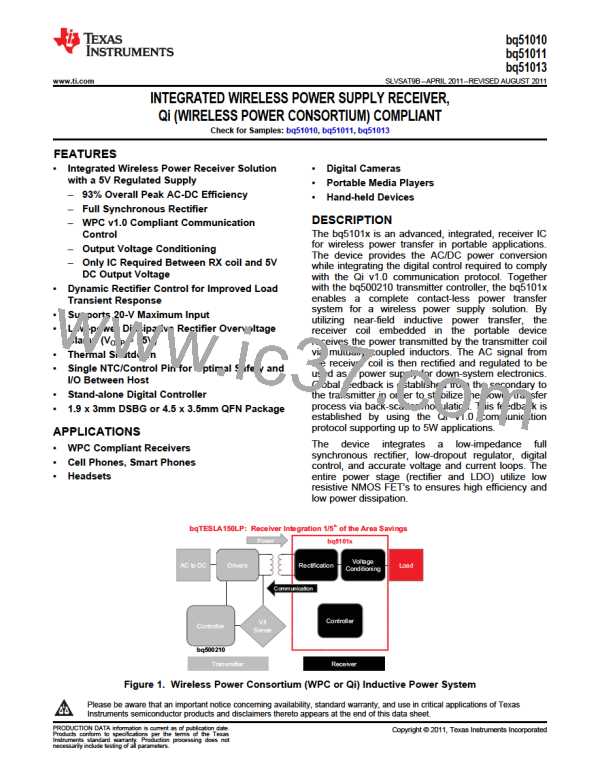bq51010
bq51011
bq51013
SLVSAT9B –APRIL 2011–REVISED AUGUST 2011
www.ti.com
PRINCIPLE OF OPERATION
bqTESLA150LP: Receiver Integration 1/5th of the Area Savings
Power
bq5101x
Voltage
Conditioning
AC to DC
Drivers
Rectification
Load
Communication
Controller
V/I
Sense
Controller
bq500210
Transmitter
Receiver
Figure 24. WPC Wireless Power System Indicating the Functional Integration of the bq5101x
A Brief Description of the Wireless System:
A wireless system consists of a charging pad (transmitter or primary) and the secondary-side equipment
(receiver or secondary). There are coils in the charging pad and in the secondary equipment which are
magnetically coupled to each other when the equipment is placed on the portable device. Power is then
transferred from the transmitter to the receiver via coupled inductors (e.g. an air-core transformer). Controlling
the amount of power transferred is achieved by sending feedback (error signal) communication to the primary
(e.g. to increase or decrease power).
The receiver communicates with the transmitter by changing the load seen by the transmitter. This load variation
results in a change in the transmitter coil current, which is measured and interpreted by a processor in the
charging pad. The communication is digital - packets are transferred from the receiver to the transmitter.
Differential Bi-phase encoding is used for the packets. The bit rate is 2-kbps.
Various types of communication packets have been defined. These include identification and authentication
packets, error packets, control packets, end power packets, and power usage packets.
The transmitter coil stays powered off most of the time. It occasionally wakes up to see if a receiver is present.
When a receiver authenticates itself to the transmitter, the transmiter will remain powered on. The receiver
maintains full control over the power transfer using communication packets.
14
Submit Documentation Feedback
Copyright © 2011, Texas Instruments Incorporated
Product Folder Link(s): bq51010 bq51011 bq51013

 TI [ TEXAS INSTRUMENTS ]
TI [ TEXAS INSTRUMENTS ]